

How to craft a great referral program with gamification? ( +8 examples)
How to craft a great referral program with gamification? ( +8 examples!)
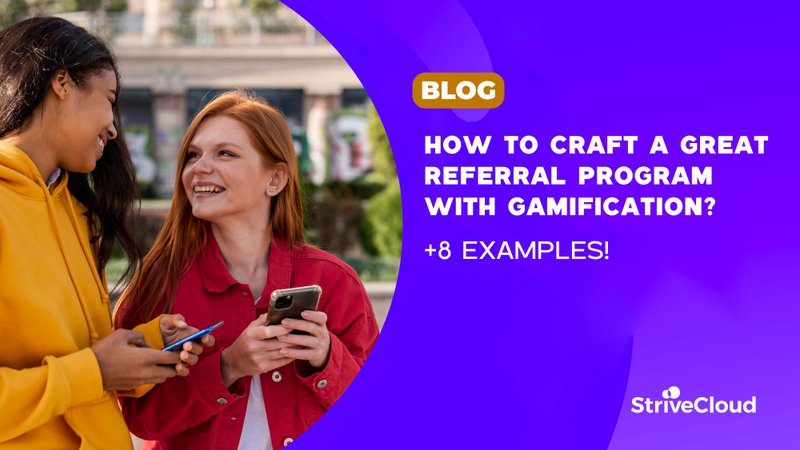
Creating a great referral program is your best option for improving user engagement metrics. As the attention span of today’s users is decreasing, companies have to choose what to employ in their referral strategy wisely. It has to capture the user’s attention immediately if a company wants a chance at gaining loyal users. Luckily, a gamified referral program does that splendidly - it sparks user curiosity and keeps them engaged!
Consequently, gamification is becoming one of the most popular ways to boost user engagement and create a great customer referral program. After all, it impacts user retention metrics greatly, lowering user churn and increasing user retention rate.
In addition, gamification creates an immersive experience. Why? Think of video games. No matter how simple the interface is, they are famous for creating immersive customer experiences and hooking their users.
This ensures that your users will stay excited to proceed with your customer referral program and recommend your platform and app to friends and family.
In other words, a great customer referral program includes gamification elements. Out of The Forbes 2000 global companies, 70% use gamification to improve their performance. If used correctly, gamification could play an essential role in your platform.
Before revealing the gamification elements that make up a great referral program, let’s uncover what “gamification” means. You need to know the term before you find out why you should use it in your referral system in detail!
We’ll also help you craft a great referral program with a step-by-step guide. To better imagine what a gamified referral program is, we’ll also discover the best industry examples!
- What is gamification exactly?
- How does gamification improve your referral system?
- Steps to creating a great referral program
- 8 examples of great referral programs with gamification
- FAQ
What is gamification exactly?
Gamification is the use of game elements and principles in non-game contexts. It taps into human emotions, such as the drive for competition and success. For the same reason, it significantly improves user interaction, motivation, and loyalty.
If you gamify your platform correctly, you will see this in your user retention metrics. For example, a streak feature should increase the number of your daily active users, and keep users motivated users to come back time after time, ultimately reducing users churn.
However, gamification is not just a tactic for engaging your audience or creating a great referral program. It’s also a way for businesses to collect data and analyze customer behavior. Companies can then use the data to create new marketing opportunities and improve their practices.
On top of that, gamification can be used at any stage of the customer journey. From introducing thrilling challenges at the awareness stage to rewarding actions that drive users into conversion, gamification supercharges key metrics at every stage of the marketing funnel.
Why is gamification crucial in crafting a great referral program?
Referral systems are an excellent option to create loyal advocates for your company. This marketing practice increases Word of Mouth, as users are motivated to spread the word for their benefit.
Gamification is common in a great referral program and for a good reason. Let’s take, for example, one of the most important user retention metrics - customer lifetime value. Astonishingly, user engagement through gamification increases CLV by 15%-40%!
One reason for this immense increase is maintaining user participation. A great referral program requires frequent interaction for users to gain rewards, or maintain their status. This level of engagement fosters a sense of loyalty towards the company. It makes the user more likely to keep participating in the program and fosters regular visits to the platform.
With gamification, users are more likely to interact with your referral program. Consequently, they share it amongst their connections to gain additional benefits or progress within the gamified system. This amplifies the reach of the program. Participants actively promote it to their friends, family, and colleagues to gain rewards or a better status.
By now it is evident that gamification gets users hooked. In any case, adding gamified experiences to a great referral program enhances user engagement, creates habitual visitors on your platform, and improves the program’s reach.
Check out how the Lime Mobility Service uses a gamified referral program to increase the likelihood of referrals!
Steps to creating a great referral program
#1 Identify which KPIs are going to determine your progress
It is important to know a progress measurement for your referral program. This could be, for example, one of the user retention metrics, such as customer retention rate from referrals. Set a goal KPI and maintain the same one after solidifying your referral system, to be able to evaluate your results effectively.
#2 Establish the rewards structure for your referral program.
Analyze your customer behavior so your referral program rewards align with their interests. Keep in mind that some of the rewards are pretty costly, so make sure you stay within your budget. Gamification is one of the most cost-effective options due to its implementation simplicity and non-tangible reward alternatives. A few examples of gamified rewards that you could include are:
- Exclusive levels or tiers: Create a tiered system where customers can unlock exclusive levels or tiers based on their referral activity. Each level comes with its own set of perks or rewards, motivating customers to refer more to reach higher levels.
- Points and leaderboards: Implement a points-based system where customers earn points for each successful referral. These points can be used for rewards or to climb up the leaderboard, fostering competition among customers and driving more referrals.
- Virtual badges or rewards: Award customers with virtual badges or rewards for their referral activity, which they can then showcase on their profile or share on social media. These virtual rewards symbolize status and encourage others to join the referral program.
#3 Decide on your referral program type and design
There are a few ways you can construct your referral program. First of all, you have to choose between two types of programs: single-sided and double-sided.
The first type only rewards the referrer. A double-sided program, on the other hand, benefits both the referrer and the referee. With double-sided programs, you have a higher chance of creating a great referral program, as both parties receive a reward. It helps you achieve two objectives at once: making your existing customers happier and attracting potential ones.
After you decide on your referral program’s type, make sure to have foolproof design elements and compelling copy.
The CTA has to be visible on your referral program page, as well as highly motivating. They have to incite to act immediately, for example, “Refer a friend now and get 50$ in your account”! As for the design, your best bet is to choose a pre-existing template. This is more efficient and will help you avoid technical errors while crafting your great referral program at a quick pace.
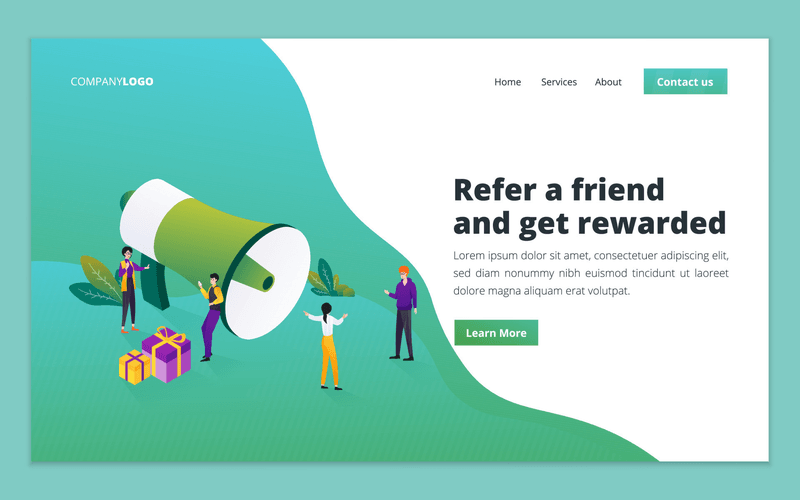
This referral program template provides a clear, visually appealing layout for users to follow.
#4 Get a versatile referral program software to ensure effectiveness
When your referral program design is finished, you have to decide on what software you’ll use to manage it. Software that not only administers your program efficiently but also nurtures customer connections is a must for a great referral program. Here are examples of what features it could include:
- Customizable reward structures: allows flexibility to choose various types of rewards, such as cash bonuses, discounts, or free products/services, and the ability to adjust their conditions according to changing customer needs.
- A/B testing: grants the ability to compare different campaigns to evaluate what works best for your customers.
- Conversion rate measurement: provides insights into how well your referral program is performing in terms of turning leads or prospects into active users.
Need a flexible reward system in your referral program? Strivecloud offers that and more!
#5 Advertise your referral system
After you publish your referral program, ensure its visibility across all customer-facing communication platforms.
- Website: Direct customers to your referral program on your company's homepage and other key pages like the account login and checkout pages. Additionally, craft a dedicated landing page, laying out all essential details of the program.
- Email: Design an email campaign outlining the benefits of your referral program and distribute it to customers who interact with your content frequently, or have voluntarily applied to receive more information. Make sure to include a CTA that encourages the customer to act immediately. The email campaign can be distributed to frequent website visitors, newsletter subscribers, and so on.
- Social Media: Social platforms such as Facebook, Twitter, Instagram, LinkedIn, and TikTok are some of the most cost-friendly options for high conversion and engagement. Creating relevant and shareable content drives traffic to your referral program without extra costs. Another helpful practice is implementing a bio link that directs followers to the program landing page to streamline the process.
The most important thing to note is that the content has to have consistent, strong messaging across all platforms. Highlight the rewards your customers can earn, and what value will their referred friends gain from the company’s products and services.
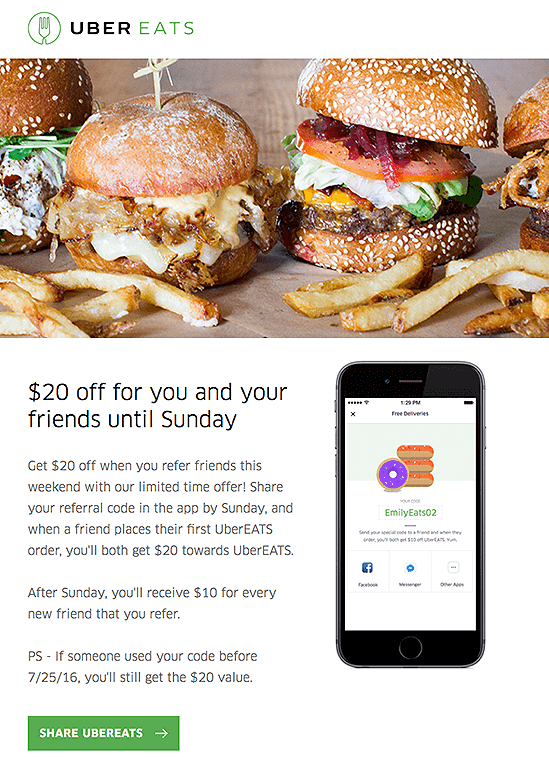
Uber Eats effectively uses email to promote its referral program with a clear call-to-action and benefit-driven copy.
8 examples of great referral programs with gamification
Badges and achievements
You’ve probably seen the badge feature on various gamified apps, and simply, your favorite video games. But did you know that this feature is essential for a good referral program?
Badges can be used in multiple ways. They motivate users to reach referral milestones and can be combined with other rewards, like discounts or coupons.
#1 Bake’s badge system fuels engagement and motivates customers with growing commissions
A crypto exchange and investment platform Bake (known as Cake in the past), boasts a great referral program. Bake incorporates four referral progress badges, based on the amount of friends that were referred by the customer. This boosts user motivation and enhances the visual appeal of achieving these milestones. What’s more, with each badge, users receive a larger percentage of Bake's commission from their friends' investments they receive!

Bake's referral program uses a badge system to visually represent a user's progress and increase their commission rate with each milestone.
#2 Mailchimp's badge offers broader access to connections
The process of Mailchimp’s customer referral program is simple: all their customers have to do is flaunt a referral badge in their emails! When someone clicks on the badge and signs up for the service, both the old and new users get a $30 discount on their Mailchimp account. This CMS uniquely integrates badges, streamlining the user acquisition process, and strengthening brand advocacy!
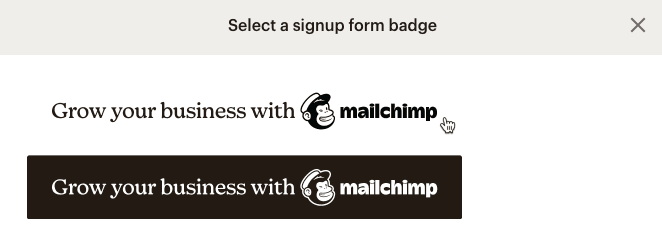
Mailchimp's simple badge system turns every email into a potential referral, rewarding both the sender and the new subscriber.
Want to implement badges to your referral program today? Book a session with StriveCloud, and ensure a smooth gamification integration!
Referral progress bars
A progress bar shows customers how much they have progressed within an initiative. This illusion of growth, similar to seeing which level you have reached in a game, nudges users to participate more.
#3 Harry's referral progress bar visualizes rewards and encourages user engagement
Harry’s is a New York-based company that sells shaving equipment via mail order. They were acknowledged for their great referral program which featured a progress bar that illustrated users' progress toward earning rewards. From receiving shave cream at five referrals to unlocking a year's supply of free blades at 50 referrals, users got better presents each time they reached a new milestone. Just by launching this program, the company received 100,000 referrals in the first week!
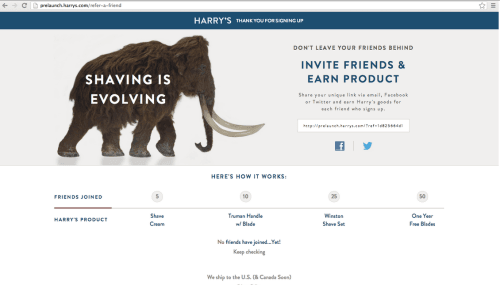
Harry's famous referral campaign used a progress bar to clearly visualize the tiered rewards, motivating users to reach the next milestone.
#4 Morning Brew’s progress bar motivates users with small nudges
Morning Brew had a great referral program, which incentivized their engaged readers to share the Brew with others. After first gathering a devoted audience, the business news website launched a few referral campaigns. One of them was referral progress bars.
Because the company already had loyal fans, it had a unique strategy. By providing nudges to become a Morning Brew Insider along the way, they were incentivizing users to prove their loyalty. Even if this is a small part of the referral system, it contributed to Morning Brew reaching an audience of 1.5 million loyal subscribers!

This example from Morning Brew shows how a progress bar can motivate loyal users to share content and earn exclusive status.
Leaderboards
Adding a leaderboard to your referral program is a great way to instill a sense of competition between your users. It’s a great way to increase sales and engagement.
Customers love to see where they stand on a referral leaderboard. The desire to be at the top of the game motivates them to acquire as many referrals as possible.
#5 Swissborg raised funds and motivated users to participate in their referral program through leaderboards
Swissborg, a Swiss-based fintech platform, needed a great referral program to spread the news about their Series A funding event. The company offered a percentage of their referral’s investment and even bigger rewards, such as a luxury watch, depending on which place on the leaderboard the user was in. The results? Swissborg’s gamified referral program attracted 16,660 investors and generated over 1 million app users!
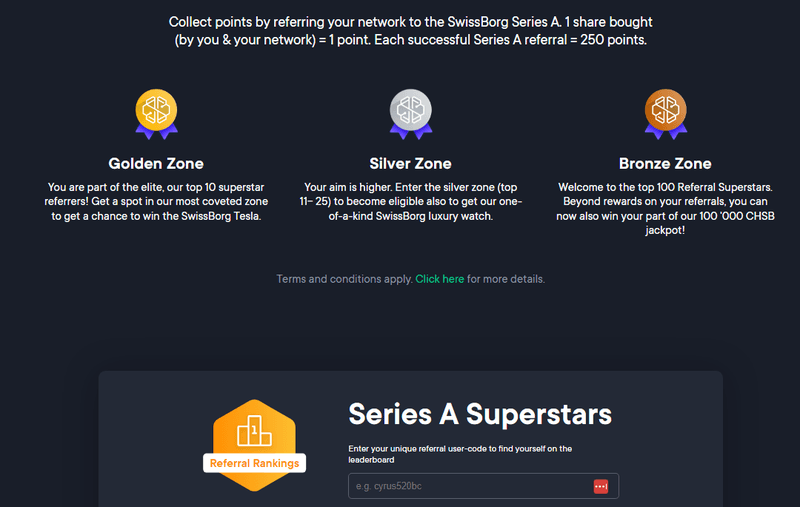
Swissborg structured its referral program around a competitive leaderboard, offering significant rewards for top performers to drive massive participation.
#6 Prezi launched a leaderboard referral program to expand its community
The presentation software Prezi created a generous tournament to expand its audience. Any person who was referred by somebody else got the first month free! However, the referee was also in a run for a prize. In the leaderboard, participants could check how many referrals they have compared to others. The one who had the most successful invites at the end of our referral program would get a USD 5,000 reward to foster remote work for their team or spend on anything they wish! Surprisingly, even users in the 2nd to 5th place could get USD 1,000 each! This campaign was a way for Prezi to advance in their competition with Powerpoint.
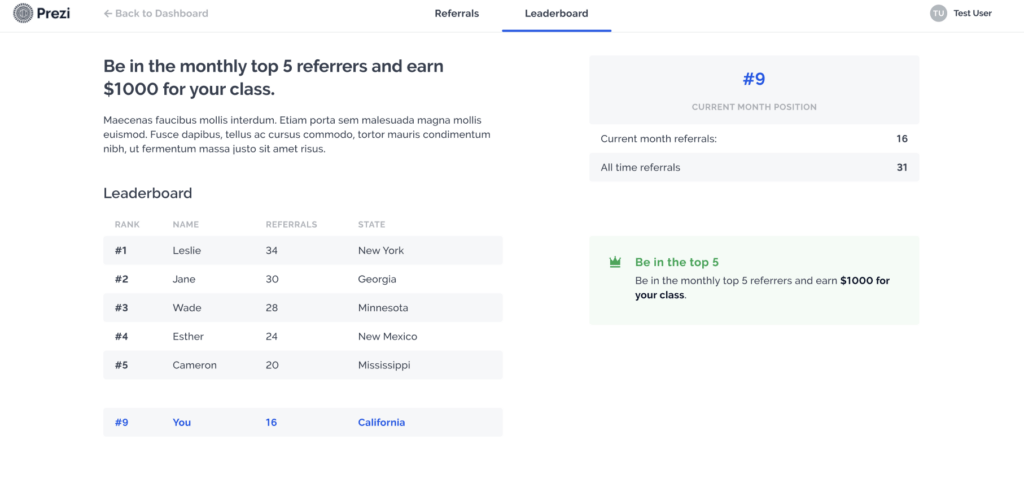
Prezi's referral leaderboard offered substantial cash prizes to the top referrers, creating a high-stakes competition to drive community growth.
Points
In games, users receive points to exchange them for avatars, exclusive goods, and secret items. This adds a layer of excitement and surprise. Without a doubt, this can also be applied to contests held in loyalty programs.
#7 Automotive company Lucid gives users points to exchange for high-end rewards
Lucid is the first luxury electric car company. However, it is not as well known as Tesla. To gain new customers, Lucid employs a great referral program. If a customer refers a friend, both them and the new car owner get points to exchange for various rewards! Evidently, receiving a car referral is harder than a simple signup. Naturally, the awards for this are impressive, ranging from a sapphire-branded leather duffel bag to a factory visit with two-night hotel accommodation. Lucid's great referral program offers enticing rewards, demonstrating a commitment to attracting new customers and distinguishing the company in the competitive electric car market.
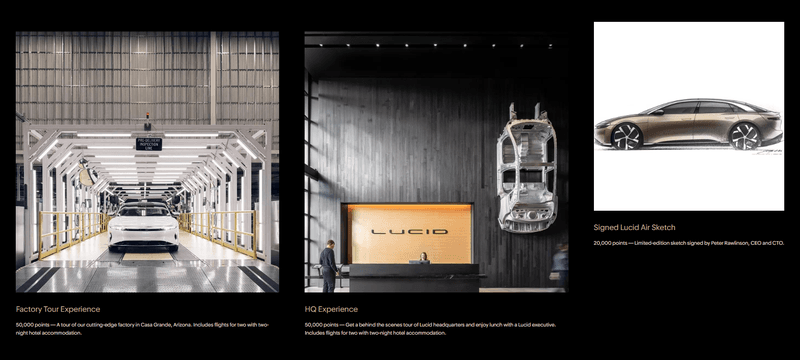
Lucid's referral program uses a points system that allows users to redeem high-value, exclusive rewards, fitting its luxury brand identity.
#8 PC Financial has exchangeable points that can be used for groceries or even pharmacy products
PC Financial, a Canadian financial service, is closely connected to the President’s choice brand. It has products ranging from grocery to retail. Naturally, their gamified rewards are related to that field! If a referred friend spends 100$ a month on their new PC Financial card, the referring gets 50$ to spend on desired products. In essence, PC Financial's integration with the President's Choice brand not only offers a diverse range of financial services but also rewards customers with benefits relevant to their everyday spending habits. This makes the company relevant to all audiences, attracting a broad variety of customers.
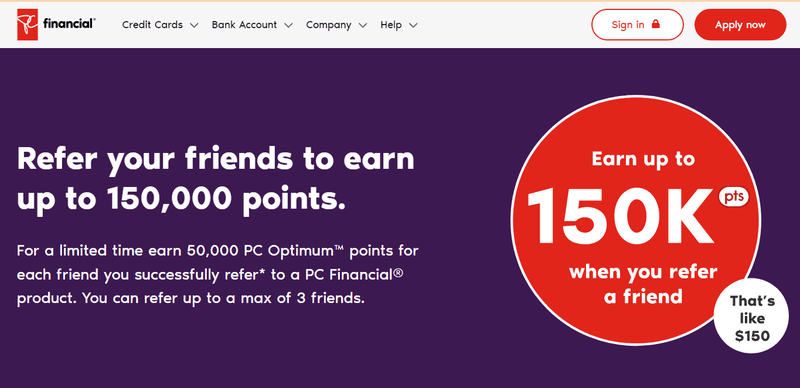
This example from PC Financial shows how points can be tied to everyday spending, making the rewards feel practical and accessible.
We envision what your gamified referral program needs. Start with our free demo!
FAQs
What is gamification exactly?
Gamification is the integration of game elements and principles into non-game contexts. By leveraging human emotions like competition and achievement, gamification significantly enhances user interaction, motivation, and loyalty.
How does gamification improve your customer referral program?
Gamification drives engagement and retention within referral systems by offering incentives and rewards for user participation. It encourages users to share the program with their networks, amplifying its reach and impact.
What are the steps to crafting a great referral program?
- Identify which KPIs are going to determine your progress
- Establish the rewards structure for your referral program
- Decide on your referral program type and design
- Get a versatile referral program software to ensure effectiveness
- Advertise your referral system

Related Posts
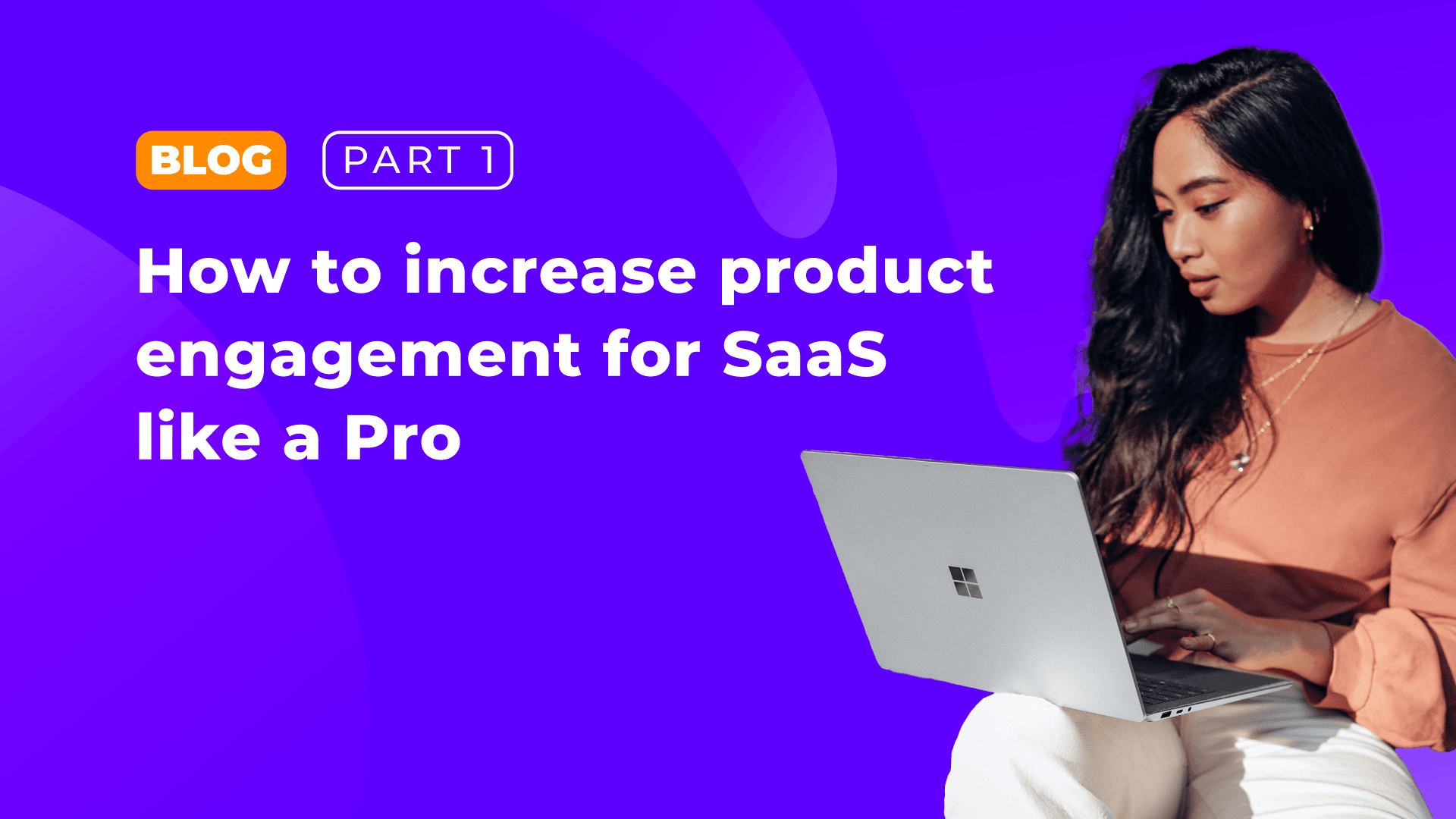
How to increase product engagement for SaaS like a Pro: Part 1
Over the last decade, SaaS grew at twice the rate of the overall market, yet profitability fell by half! In short, competition is stiffer - and this means you need to learn how to increase product engagement like a Pro. Get started with Part I of our definitive guide.

Best tournament platforms to keep gamers engaged
What is the best tournament platform to keep gamers engaged? Today's gamers want more than just to play the game. They're looking to fulfill the 3C's of gaming marketing: competition, community & content. How can you fill in that need? And which platform is right for you?

